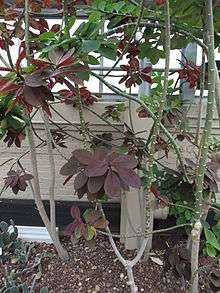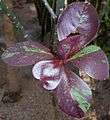Euphorbia grantii
Euphorbia grantii is a species of succulent plant in the family Euphorbiaceae.
| Euphorbia grantii | |
|---|---|
 | |
| Scientific classification | |
| Kingdom: | Plantae |
| Clade: | Tracheophytes |
| Clade: | Angiosperms |
| Clade: | Eudicots |
| Clade: | Rosids |
| Order: | Malpighiales |
| Family: | Euphorbiaceae |
| Genus: | Euphorbia |
| Species: | E. grantii |
| Binomial name | |
| Euphorbia grantii | |
| Synonyms[1] | |
Name
The specific epithet is in honour of explorer James Augustus Grant.[2] It was originally described by Daniel Oliver in 1875.[3] The plant has the common name of African milk bush. The synonym Synadenium grantii is in circulation, too.
Distribution
The plant is native in the African tropics, in particular in Malawi, Kenya and Uganda.[4] It grows at altitudes of 500–2100 meters. It has been introduced in many other tropical regions.
Usage
It is often grown as a hedge plant and as a traditional grave marker among the peoples of central Kenya (Agĩkũyũ, Akamba, etc.).[5]
In 1952 during the Mau Mau Uprising, the poisonous latex of the plant was used to kill cattle in incidents of biological warfare.[6]
Gallery
References
- The Plant List (2013). Version 1.1. Published on the Internet; http://www.theplantlist.org/tpl1.1/record/kew-79947 Archived 17 March 2019 at the Wayback Machine (accessed 28 September 2017).
- Oliver, Daniel. 1875. Transactions of the Linnean Society of London, 29(3): 144.
- "Euphorbia grantii". International Plant Names Index (IPNI). Royal Botanic Gardens, Kew. Retrieved 12 July 2010.
- Synadenium grantii Hook.f., The Encyclopedia of Succulents. http://www.llifle.com/Encyclopedia/SUCCULENTS/Family/Euphorbiaceae/23048/Synadenium_grantii Archived 6 June 2019 at the Wayback Machine
- (Book) Trees of Kenya, by Tim C. Noad and Ann Birnie, p.109, Self-Published in Nairobi, Kenya 1989
- Bernard Verdourt, E.C. Trump and M.E. Church (1969). Common poisonous plants of East Africa. London: Collins. p. 254.
.jpg)

.jpg)
.jpg)

.jpg)